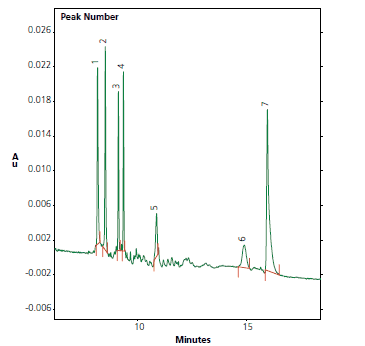What is Isoelectric Focusing?
Isoelectric focusing (IEF) is a powerful analytical tool for the separation of proteins. In order to ensure the high performance of analysis, isoelectric point (pI) standards are needed. In addition to classical protein based standards, low molecular weight compounds have been developed and successfully examined in capillary IEF and IEF-gel electrophoresis. Gel electrophoresis, the common technology for IEF, minimizes convection and introduces an additional gel-sieving effect to separate proteins by size. However, it has several disadvantages such as lengthy analysis time, limited resolution, and difficulty in detection. These challenges have been largely overcome by the development of IPG-strips (immobilized pH gradients) for use in high-resolution pI-separation.
Capillary electrophoresis is a high-resolution approach to separate molecules, based on the pI point, that can be automated. Separation is carried out in fused-silica capillaries with internal diameters of 25-75 μM. The electrophoresis takes place in free solution and the capillary controls convection currents. After focusing is complete, the solutes are pumped out of the capillary. UV absorption is the most popular detection method for capillary IEF, but UV induced fluorescence emission is of interest for derivatized proteins. Dansyl chloride, fluorescamine, o-phthaldialdehyde, and coumarin moieties are used to increase detection sensitivity.
One of the most critical issues in isoelectric focusing, whether in capillary electrophoresis or slab gel, is standardization of results. For that purpose typical protein standards have been used which could show certain disadvantages:
- Limited stability of solutions
- Inadequate purity for application as a standard
- Lot-to-lot inconsistency
To overcome these problems, we introduced synthetic IEF-markers, which can be used for fluorescent detection. The fluorescent IEF-markers enable a much higher sensitivity than using UV detection, as is commonly used with slab gel electrophoresis. The maximum absorbances of the individual markers are between 308 and 350 nm. For fluorescence detection, an excitation wavelength of 310 nm is suggested (individual excitation maxima range between 310 to 400 nm); the emission maxima of the individual markers are between 410 and 500 nm (Figure 1). An advantage in IEF gel electrophoresis with fluorescent IEF-markers is the ability to control the formation of a gradient without further staining (using UV illumination).

Figure 1. CE-IEF with different fluorescent pI Markers: 1, pI 10.2; 2, pI 9.0; 3, pI 7.6: 4, pI 7.2; 5, pI 5.5; 6, pI 4.0; 7, pI 3.0.
Materials
Reference
To continue reading please sign in or create an account.
Don't Have An Account?